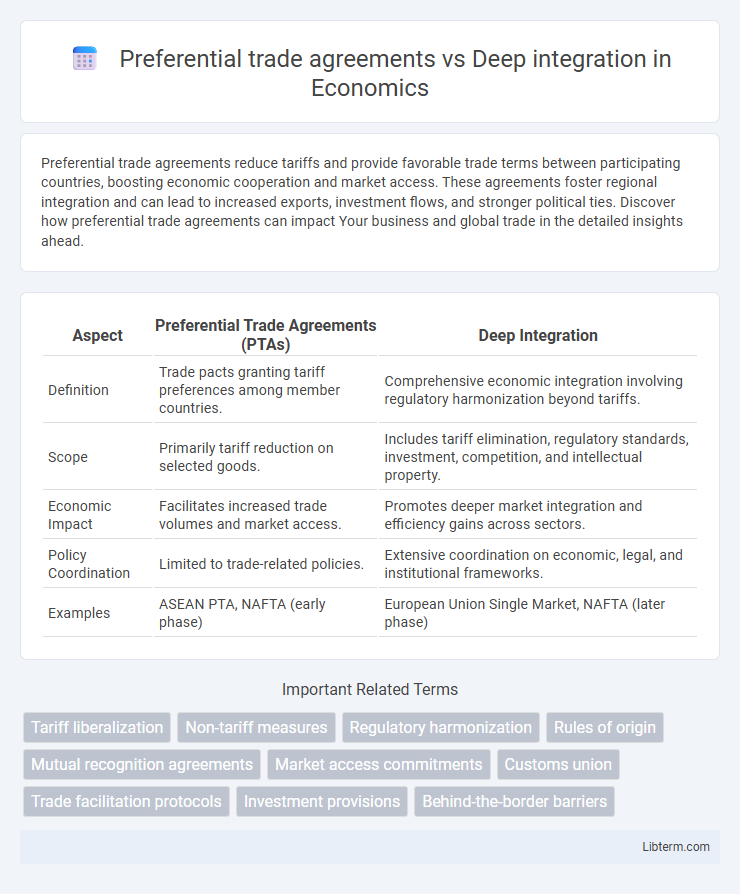Preferential trade agreements reduce tariffs and provide favorable trade terms between participating countries, boosting economic cooperation and market access. These agreements foster regional integration and can lead to increased exports, investment flows, and stronger political ties. Discover how preferential trade agreements can impact Your business and global trade in the detailed insights ahead.
Table of Comparison
| Aspect | Preferential Trade Agreements (PTAs) | Deep Integration |
|---|---|---|
| Definition | Trade pacts granting tariff preferences among member countries. | Comprehensive economic integration involving regulatory harmonization beyond tariffs. |
| Scope | Primarily tariff reduction on selected goods. | Includes tariff elimination, regulatory standards, investment, competition, and intellectual property. |
| Economic Impact | Facilitates increased trade volumes and market access. | Promotes deeper market integration and efficiency gains across sectors. |
| Policy Coordination | Limited to trade-related policies. | Extensive coordination on economic, legal, and institutional frameworks. |
| Examples | ASEAN PTA, NAFTA (early phase) | European Union Single Market, NAFTA (later phase) |
Introduction to Preferential Trade Agreements (PTAs)
Preferential Trade Agreements (PTAs) are trade pacts between countries that reduce tariffs and trade barriers on selected goods to boost bilateral or regional commerce. PTAs offer a limited scope of liberalization compared to deep integration, focusing primarily on tariff preferences without encompassing extensive regulatory or policy harmonization. These agreements serve as a stepping stone toward deeper economic integration by fostering closer trade relations and reducing costs for member nations.
Defining Deep Integration in International Trade
Deep integration in international trade involves harmonizing regulations, standards, and policies across countries to facilitate seamless economic cooperation beyond conventional tariff reductions found in preferential trade agreements (PTAs). It encompasses areas such as labor laws, environmental standards, intellectual property rights, and competition policies, aiming to create a unified market with minimized non-tariff barriers. Unlike PTAs, which primarily grant preferential tariff access, deep integration fosters structural reforms that enhance overall economic efficiency and institutional compatibility between partner nations.
Key Features of Preferential Trade Agreements
Preferential trade agreements (PTAs) primarily offer reduced tariffs or trade barriers on specific goods between member countries, fostering increased market access and trade volume without full economic integration. They are typically limited in scope, focusing on tariff preferences rather than harmonizing regulations, policies, or standards across sectors. PTAs lack the comprehensive institutional frameworks and policy coordination seen in deep integration initiatives, which aim for broader economic convergence beyond trade preferences.
Components of Deep Integration Frameworks
Preferential trade agreements (PTAs) primarily concentrate on reducing tariffs and quota restrictions between member countries, whereas deep integration frameworks involve comprehensive regulatory harmonization, including standards for product quality, intellectual property rights, and dispute resolution mechanisms. Components of deep integration frameworks encompass legal alignment, coordinated competition policies, and mutual recognition of regulations to facilitate seamless cross-border trade and investment flows. This multidimensional approach fosters stronger economic interdependence and addresses non-tariff barriers beyond the scope of conventional PTAs.
Economic Impacts: PTAs vs Deep Integration
Preferential trade agreements (PTAs) primarily reduce tariffs and quotas among member countries, boosting trade volumes and short-term economic growth by enhancing market access. Deep integration extends beyond tariff reductions, encompassing regulatory harmonization, investment facilitation, and labor mobility, leading to more substantial productivity gains and long-term structural economic benefits. Studies indicate that economies engaged in deep integration experience higher GDP growth rates and increased competitiveness compared to those participating only in PTAs.
Regulatory Harmonization and Policy Alignment
Preferential trade agreements (PTAs) typically reduce tariffs between member countries but maintain distinct regulatory frameworks, limiting regulatory harmonization and policy alignment. In contrast, deep integration involves comprehensive regulatory harmonization, aligning standards, rules, and policies across countries to facilitate seamless economic interaction. This alignment in deep integration enhances cross-border trade efficiency by minimizing non-tariff barriers and fostering policy consistency among member states.
Market Access and Trade Facilitation Differences
Preferential trade agreements (PTAs) primarily enhance market access by reducing tariffs and quotas among member countries, facilitating easier trade flows through lower barriers. Deep integration goes beyond PTAs by harmonizing regulations, standards, and customs procedures, significantly improving trade facilitation and minimizing non-tariff barriers. While PTAs focus on tariff concessions, deep integration targets systemic changes that streamline cross-border trade and deepen economic cooperation.
Case Studies: Examples of PTAs and Deep Integration Blocs
Preferential Trade Agreements (PTAs) like the North American Free Trade Agreement (NAFTA) primarily aim to reduce tariffs between member countries, enhancing trade flows without extensive policy harmonization. Deep integration blocs, exemplified by the European Union (EU), go beyond tariff reduction by aligning regulatory standards, labor laws, and monetary policies to create a more seamless economic union. Case studies from ASEAN PTAs show modest tariff preferences, whereas the EU demonstrates comprehensive integration that fosters not only trade but also political and social cooperation.
Challenges and Criticisms of Both Approaches
Preferential trade agreements (PTAs) face challenges such as limited scope, complex rules of origin, and trade diversion, which can undermine global trade efficiency. Deep integration encounters criticisms related to sovereignty loss, regulatory harmonization difficulties, and political resistance from stakeholders wary of extensive policy convergence. Both approaches often struggle with balancing economic benefits against political and social costs, complicating their implementation and effectiveness.
Future Trends: Evolving Nature of Trade Agreements
Future trends in trade agreements emphasize the shift from traditional Preferential Trade Agreements (PTAs), which primarily reduce tariffs and quotas, toward Deep Integration frameworks that encompass regulatory harmonization, digital trade rules, and environmental standards. Emerging agreements increasingly address non-tariff barriers and cooperative mechanisms for technology transfer, reflecting the complex dynamics of global value chains and digital economies. This evolution underscores the growing importance of comprehensive trade policies that transcend conventional tariff preferences to promote sustainable, inclusive, and resilient economic partnerships.
Preferential trade agreements Infographic

 libterm.com
libterm.com